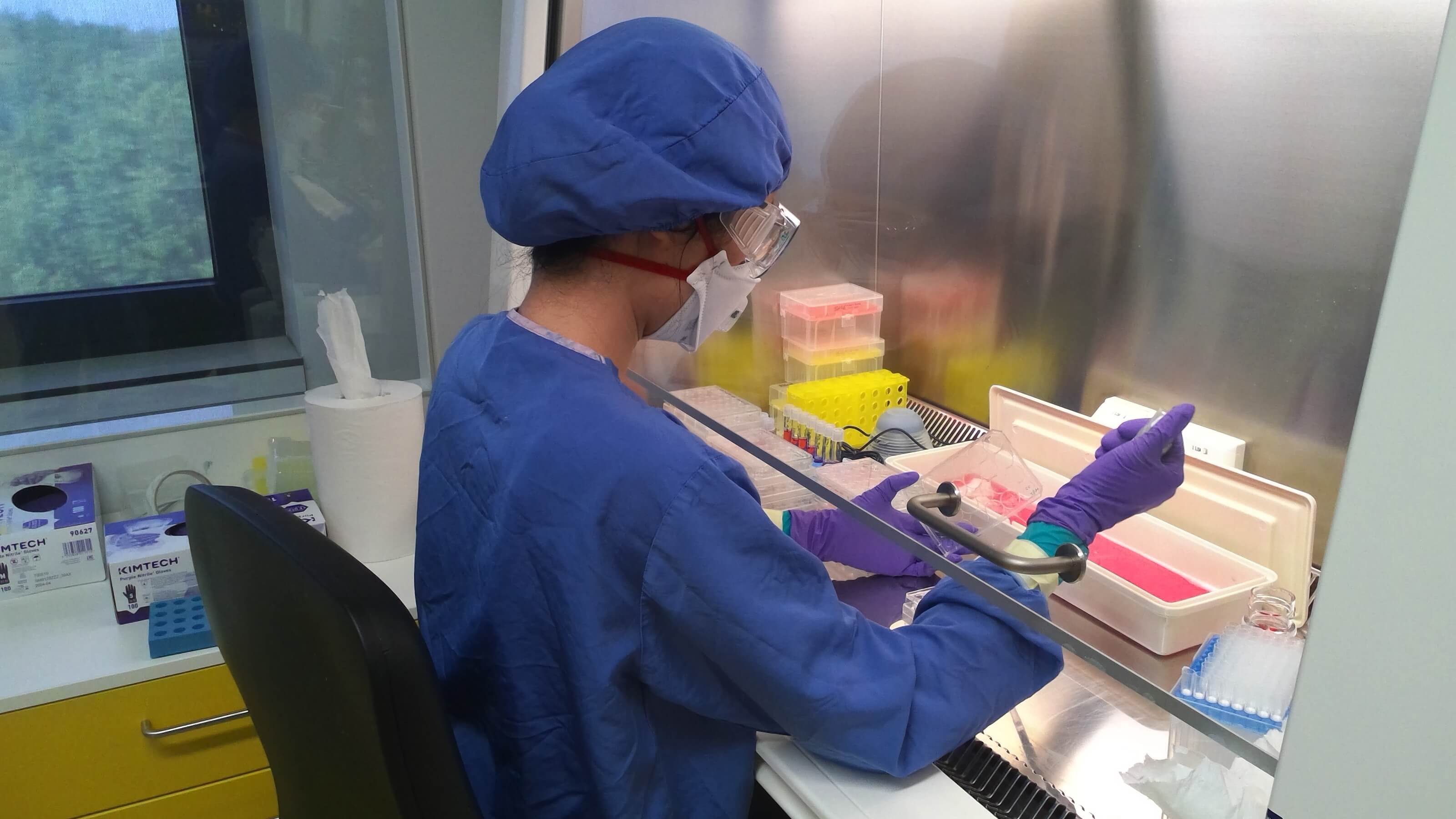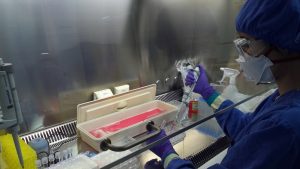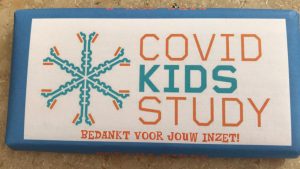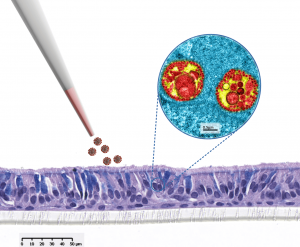
27 May COVID-19 and OrganoVIR
The COVID-19 crisis has affected the entire world and has also impacted the OrganoVIR network. With non-COVID research activities being stopped, several of our research projects were put on hold.
Our partners adjusted to the COVID-19 situation as quickly as possible and have contributed in various ways to COVID-19 research such as by implementing COVID-19 in already ongoing research and working on the development of new antivirals for COVID-19. As COVID-19 is a highly pathogenic virus, not every laboratory has the facilities to immediately implement COVID-19 into their research. On top of that, many laboratories were prohibited to work on non-COVID-19 related research activities. This had immediate implications for nearly all of the Early Stage Researcher projects.
Within OrganoVIR, COVID-19 activities are being carried out by various partner organizations. A short overview of their COVID-19 activities are provided below.
KU Leuven
The Virology and Chemotherapy Laboratory at the Rega Institute, which is led by Professor Johan Neyts, is working hard on finding other antivirals that can help COVID-19 patients defeat the disease.
The lab is collaborating with research centers in Leiden, Aix-Marseille, Utrecht, Bern, Lübeck and Braunschweig, while receiving financial support from the EU.
Professor Johan Neyts’ team is studying the way in which known coronaviruses evolve and are searching out possible targets for further attacks against the virus. In addition, they’re investigating whether there is an active substance in an existing medicine, or a combination of substances, that’s effective against these viruses.
In addition, Professor Neyts’ team will, on behalf of the Bill & Melinda Gates Foundation, also test 15,000 active ingredients in both existing drugs and drugs under development for their effectiveness against SARS-CoV-2. CD3 (Centre for Drug, Design & Development) and Johnson & Johnson are also making thousands of these components available to the lab.
Besides the search for antivirals, Professor Neyts’ team is also working on developing a vaccine for COVID-19. His team is using a technology based on the yellow fever vaccine. Researchers at KU Leuven are currently conducting pre-clinical tests. If these tests provide encouraging results, Professor Neyt’s team can then start testing the prototype of the vaccine on healthy volunteers.

Jagiellonian University
Krzysztof Pyrc’s virology group has set up a clinical diagnostics lab at the Malopolska Centre of Biotechnology (MCB) at the Jagiellonian University, where Pyrc’s group is testing patients from their voivodship to support the sanitary service. Pyrc’s group is collaborating with companies to create a POC diagnostics based on different platforms. They hope to have these before autumn.
In addition, Pyrc’s group is studying the infection on the single-cell and tissue level using HAE cultures (for additional papers, click here and here). The group is not limiting their research to the lung cells/tissue but also studying different organs and cell types.
Furthermore, Pyrc’s group is monitoring the virus variability in Poland using Next Generation Sequencing (NGS). For now, the group has released the first and only sequence of the Polish isolate and isolated the virus for further studies on the phenotype/genotype correlation. Pyrc’s group is now finishing the sequencing of >100 strains and isolating all of these (several are already available at GISAID).
Additionally, Pyrc’s group is also studying the course of the pandemic in Poland. They already initiated the serological survey in people that were not “officially” sick. The pilot study shows that ~2% of people living in Krakow has already gone through the infection. The study will be continued at the national level. Furthermore, Pyrc’s team is trying to track the virus in environmental samples, to be able to predict the local outbreaks. Preliminary data shows that it is possible to “see” the virus in the city on ATMs, ticket machines, and other surfaces in public spaces. Correlation of such environmental contamination with the COVID-19 frequency of occurrence would allow for faster and more effective response.
Moreover, Pyrc’s group is also working on virus inhibitors, both originating from their lab and repurposed. They are also collaborating with a number of units on drug testing and development.
Amsterdam UMC
Due to the COVID-19 crisis, the PhD students doing their research at the Amsterdam UMC had to abandon their work in the lab. OrganoVIR’s coordinators, Katja Wolthers and Dasja Pajkrt, were needed in the hospital to perform clinical and diagnostic tasks.
Katja and Dasja took initiative to set up new COVID-19 research at the Amsterdam UMC, which resulted in the launch of COVID-KIDS, a study on immunity in children, and the use of 3D culture models for COVID-19 studies. The Amsterdam UMC is closely collaborating with partners inside and outside of the OrganoVIR network on both of these studies.

Updated on 1-7-2020
Utrecht University
The research group of Frank van Kuppeveld, composed of the University of Utrecht, Erasmus Medical Center and Harbour BioMed, is the first group in the world to discover a human monoclonal antibody that neutralizes SARS-CoV-2 (and SARS-CoV) in a cell culture. This antibody still needs to be tested on humans.
In June 2020 the research group has entered into a collaboration with AbbVie to develop a novel antibody therapeutic to prevent and treat COVID-19. The collaboration will focus on advancing the human neutralizing antibody 47D11 that was discovered by the research group and that was recently reported in Nature Communications.
Find out more about the collaboration here.
DTU Health Tech
Our partner Martin Dufva from DTU Health Tech is participating in the project Presort that focuses on the development of a test device that can detect any virus, including COVID-19. The device will allow for blood and saliva samples to be analysed and will give an indication of whether a person’s disease symptoms are caused by a viral infection. This new technology is very rapid (the test will take less than 2 minutes) and should be seen as a presorting before running a Polymerase Chain Reaction (PCR) test.
Read more about the new technology here.
University of Geneva
The research group of the Microbiology and Molecular Medicine Department, which is led by Prof. Caroline Tapparel, is currently working on a project in which they test the activity of nano material based antivirals mimicking widely used viral attachment receptors (heparan sulfate and sialic acid) against SARS-CoVs and the other coronaviruses. The goal is to prepare a drug that is not only valuable against SARS-CoV-2, but that has a strong probability to work against the next coronavirus outbreak. In parallel to this, the research group also assesses the interaction of SARS-CoV-2 with the commensal bacteria of the respiratory tract.
Read more about the research here.
Updated 10-7-2020
STEMCELL Technologies, Inc.
As a member of the global scientific community, partner STEMCELL Technologies is committed to supplying the necessary research tools to support COVID-19 research and is collaborating directly with researchers working on the novel SARS-CoV-2 virus that causes COVID-19. In an effort to accelerate discovery and support the measures being undertaken for public health, STEMCELL has contributed specialized tools and expertise to the research community.
Very early in research efforts, STEMCELL’s PneumaCult medium was used to grow the epithelial cells from which the virus was isolated and sequenced. STEMCELL helped accelerate this early work on the virus by providing complimentary products to COVID-19 researchers in China.
As the pandemic progressed, so did global research efforts to support vaccine, diagnostic and therapeutic development efforts. By early April, STEMCELL products were being used in over 30 COVID-19 studies across the globe, and STEMCELL scientists were involved in direct collaborations with researchers. One of these collaborations involved partnering with an international team, including Dr. Josef Penninger at the University of British Columbia, along with Nuria Montserrat in Spain, Drs. Haibo Zhang and Art Slutsky from Toronto, and Ali Mirazimi’s infectious biology team in Sweden. This research effort used STEMCELL’s organoid systems to study how SARS-CoV-2 infects patients and generated insight into a potential treatment capable of stopping early infection. STEMCELL also manufactured custom cell isolation products to support the efforts of Dr. James Crowe at the Vanderbilt Vaccine Center to isolate specific immune cells from the blood of COVID-19 survivors with the aim of rapid vaccine and antibody-based therapeutic development.
STEMCELL has taken stringent steps to ensure the safety of its employees and the wider communities in which they operate. By early March, 2020, all office staff were working remotely from their homes, and strict policies were put in place to ensure the well-being of essential on-site staff and limiting the risk of viral spread within the community. To aid in these efforts, STEMCELL launched the “My Status” app to help keep staff safe and to keep management informed of staff location and wellness. The app, which was developed in a single day using OutSystems low-code, has helped to enable STEMCELL to maintain production of materials key to many SARS-CoV-2 research projects. STEMCELL has also donated the application source code so that a generic version of the app can be made available to the broader developer community as a free-to-use template.
More information on specific initiatives from STEMCELL in COVID-19 research and community support, including COVID-19 publications using STEMCELL products, can be found here.
Epithelix Sarl
The first step of SARS-CoV-2 infection is taking place in airway epithelial cells. Partner Epithelix Sarl has therefore developed and is offering standardized air-liquid interface 3D human airway epithelial cultures from nasal or bronchial (MucilAir™) and small-airway (SmallAir™) origins. These epithelial cells, expressing ACE2, closely mimic the morphology and function of the native tissues: such as cilia formation and beating, mucus production and secretion, mucociliary clearance, and secretion of antiviral molecules. These models have been successfully used to characterize viral infection kinetics, tissue-level tropism and transcriptional immune signatures induced by SARS-CoV-2.
MucilAir™ and SmallAir™ are used as screening platform for the preclinical evaluation of antiviral candidates in the context of repositioning of marketed drugs or evaluation of novel therapies and combinations delivered systematically or through aerosol devices.
Read more about Epithelix Sarl here.

